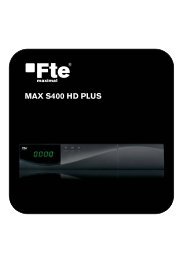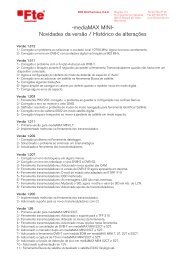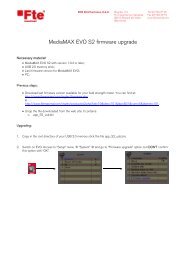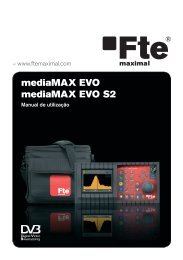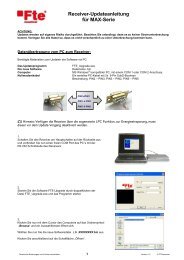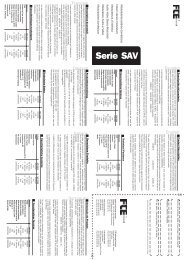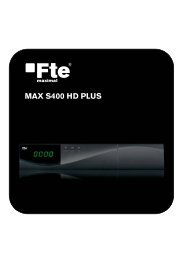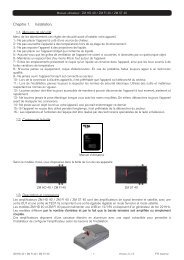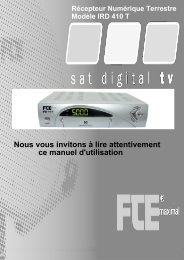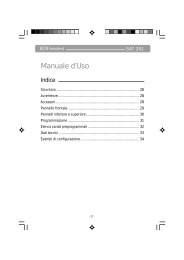TWSF 310 CI - Fte maximal
TWSF 310 CI - Fte maximal
TWSF 310 CI - Fte maximal
You also want an ePaper? Increase the reach of your titles
YUMPU automatically turns print PDFs into web optimized ePapers that Google loves.
User’s manual · <strong>TWSF</strong> <strong>310</strong> <strong>CI</strong><br />
1. This field shows the type of parameter that is selected at the moment.<br />
Options: Input Sat, Out Terr, Out TV.<br />
2. This field shows the parameter that is selected. In order to move<br />
around the different options we have to use the “Up” and “Down” buttons<br />
of the keyboard.. Click on OK to edit the selected parameter and<br />
Right/Left for changing it. Once it is configured press OK.<br />
Satellite input ( Input Sat)<br />
In these options you will be able to configure the input parameters of the satellite<br />
signal:<br />
- L.O. freq (Local oscillator): Selection of the local oscillator that you wish to use:<br />
FI, KU, C, K9750, K10000, K10600, K10700, K10750, K11250, K11300,<br />
K11325.<br />
- Freq (Input Frequency (MHz)): Transponder frequency that you wish to tune. In order to introduce the frequency, press<br />
the “OK” button and the cursor will be placed over the frequency. With the keys of the cursor, we can move through all the<br />
digits and change the values. Press “OK” in order to save the value.<br />
- Symbol Rate: Symbol speed required by the transponder. In order to introduce the symbol rate, press the “OK” button and<br />
the cursor will be placed over the frequency. With the keys of the cursor, we can move through all the digits and change<br />
the values. Press “OK” in order to save the value.<br />
- Antenna: Feeding/tone towards the LNC. Options: 0V, 13V, 13V+22kHz, 18V, 18V+22KHz, 13V+AUT, 18V+AUT.<br />
- DiseqC: In this option you can set the DiseqC configuration: A, B, C, D and None.<br />
- Auto SR (Auto Symbol Rate): You will be able to select if the detection of the Symbol Rate is going to be Automatic (On)<br />
or Manual (Off).<br />
- In Manual mode (Off), the value of the Symbol Rate should be fixed by the user based on the provider’s<br />
information.<br />
- In Automatic mode (On), the meter will automatically identify the SR when a Satellite carrier is tuned. This<br />
feature is very useful when the provider’s information is unknown.<br />
The SR value found will appear in the field of selection of the SR menu. This value found by the meter could not<br />
correspond exactly to the real broadcast SR, but to a very close value.<br />
Note: The Automatic Symbol Rate feature does not work when the carrier quality is very poor or/and with a very<br />
low Power Level.<br />
- Mode: This option allows selecting the standard DVB of the transponder that you want to tune. Options: DVB-S1, DVB-<br />
S2 and auto.<br />
Terrestrial modulation (Out Terr)<br />
These options allow configuring the DVB-T/DVB-H modulator of the device.<br />
- Modulation: Output modulation format: QPSK (4 QAM), 16 QAM, 64 QAM.<br />
- Invert (Spectrum inversion): Activate or deactivate the spectrum reverse in the<br />
modulation.<br />
- GI (Guard interval): Allows selecting the guard interval of the modulation: 1/4, 1/8, 1/16 and 1/32.<br />
- BW (Bandwidth): Selection of the Bandwidth of the modulated signal: 8 MHz, 7 MHz and 6 MHz and 5MHz. The 5 MHz<br />
option is only supported by DVB-H standard.<br />
- Tx Mode (FFT Mode): 8K, 4K and 2k. The 4k option is only supported by DVB-H standard.<br />
- FEC: Indicates the relationship between the redundant bits and the transmitted information bits:1/2, 2/3, 3/4, 5/6 y<br />
7/8. For example, in a FEC = 2/3 relation we will find 2 information bits and 1 redundant bit.<br />
- Mode: Selection of the modulation standard: DVB-T and DVB-H.<br />
Note: The output useful bits rate will depend on the following parameters: Bandwidth, guard interval, FEC<br />
codification and modulation. In the Attachment I you will find all the information related to the resulting useful bit<br />
rate in each configuration.<br />
Output configuration ( TV output)<br />
In these options you can configure the output parameters of the terrestrial signal.<br />
- RF Channel (MHz): Output frequency of terrestrial modulation. In order to<br />
introduce the frequency, press the “OK” button and the cursor will be placed over<br />
the frequency. With the keys of the cursor, we can move through all the digits and<br />
change the values. Press “OK” in order to save the value. Options: 47-862 MHz.<br />
- RF Level: Regulation of the output level of the modulated signal. Options: 0-15dB.<br />
<strong>TWSF</strong><strong>310</strong><strong>CI</strong> *Input Sat<br />
RF level: 013<br />
>LO Freq: LO KU<br />
Freq: 11509<br />
<strong>TWSF</strong><strong>310</strong><strong>CI</strong> *Input Sat<br />
Symbol Rate: 27500<br />
>Antenna: 13V+22k<br />
Diseqc: NONE<br />
<strong>TWSF</strong><strong>310</strong><strong>CI</strong> *Out Terr<br />
Modulation: 4<br />
>Invert: No<br />
GI: 1/32<br />
<strong>TWSF</strong><strong>310</strong><strong>CI</strong> *Out TV<br />
Mode: DVB-H<br />
>RF Channel: 474000<br />
RF Level: 013<br />
- 12 - <strong>TWSF</strong> <strong>310</strong> <strong>CI</strong> version_en_1.0 FTE <strong>maximal</strong><br />
1<br />
2





